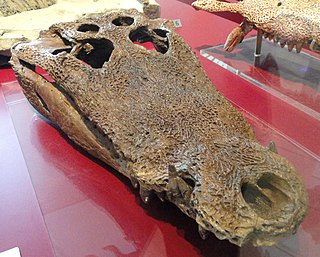
Amblyseius is a large genus of predatory mites belonging to the family Phytoseiidae. Many members of this genus feed on other mites such as red spider mites, and also on thrips. Several species are popular as biological control agents to control these pests.
The toothy splayfoot salamander, also known as the toothy salamander, is a species of salamander in the family Plethodontidae. It is endemic to Mexico and known from southeastern Hidalgo, Tlaxcala, and south-central San Luis Potosí, at elevations of 1,070–2,440 m (3,510–8,010 ft) asl.
Plecodus multidentatus is a species of cichlid endemic to Lake Tanganyika. This species is a scale-eater, eating the scales off of other fishes. This species can reach a length of 12 centimetres (4.7 in) TL.

Leidyosuchus is an extinct genus of alligatoroid from the Late Cretaceous of Alberta. It was named in 1907 by Lawrence Lambe, and the type species is L. canadensis. It is known from a number of specimens from the middle Campanian age Dinosaur Park Formation. It was a medium-sized alligatorid, with a maximum skull length greater than 40 centimeters (16 in).

Ichthyodectes is an extinct genus of ichthyodectid fish which lived during the Late Cretaceous. Fossils of the species included have been found from Canada to Texas.
Amblyseius americanus is a species of mite in the family Phytoseiidae.
Amblyseius ampullosus is a species of mite in the family Phytoseiidae.
Amblyseius andersoni is a species of mite in the family Phytoseiidae. It is found in Europe.
Amblyseius animos is a species of mite in the Phytoseiidae family. It was described by A.S. Khan, M. Afzal and Shamshad Akbar in 2000, and is known from Pakistan.
Amblyseius bellatulus Tseng is a species of mite in the Phytoseiidae family that is native to Taiwan. It was described by Tseng Yi-Hsiung in 1983. Following his retirement, Tseng's collection of more than 20 holotypes of Taiwanese phytoseiid fauna were lost. A. Bellatulus re-described in 2017 by a team from National Taiwan University led by Liao Jhih-Rong, who collected new specimens of phytoseiid mites from the original locale used by Tseng as well as other areas throughout Taiwan.
Gamasolaelaps multidentatus is a species of mite in the family Veigaiidae.
Amblyseius perlongisetus is a species of mite in the family Phytoseiidae.

Amblyseius tamatavensis is a species of mite in the family Phytoseiidae.

Dalophis is a genus of eels in the snake eel family Ophichthidae. It currently contains the following species:
Dalophis multidentatus is an eel in the family Ophichthidae. It was described by Jacques Blache and Marie-Louise Bauchot in 1972. It is known from a single specimen collected from the Saloum River in Senegal, in the eastern Atlantic Ocean. It is known through this specimen to form burrows in sand or mud on the continental shelf, and to dwell at a depth of 50 metres. Males are able to reach a total length of 15.3 centimetres.
Dermatobranchus multidentatus is a species of sea slug, a nudibranch, a marine gastropod mollusc in the family Arminidae.
Typhlodromips swirskii, the Swirski mite, is a species of predatory mite in the family Phytoseiidae. It is used in biological pest control of western flower thrips in greenhouse or indoor grown crops.
Pandanus multidentatus a species of plant in the family Pandanaceae. It is native to Vanuatu.




